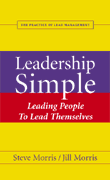 I recently stumbled across a wonderful little book called Leadership Simple: Leading People to Lead Themselves, by Steve and Jill Morris. It’s based on Dr. William Glasser’s “Choice Theory” (which suggests, among other things, that the only person whose behavior we control is our own) and Glasser’s “Reality Therapy” (which suggests that we choose our actions and we are responsible for our choices.)
I recently stumbled across a wonderful little book called Leadership Simple: Leading People to Lead Themselves, by Steve and Jill Morris. It’s based on Dr. William Glasser’s “Choice Theory” (which suggests, among other things, that the only person whose behavior we control is our own) and Glasser’s “Reality Therapy” (which suggests that we choose our actions and we are responsible for our choices.)
The authors use a fictional case study written in narrative format to illustrate the process of “Lead Management”, or “self-evaluating, and leading other to do the same.” The principles are also presented in bullet-point format in an appendix, which makes it very easy to quickly review the main points.
The Lead Management process involves walking oneself (and later others) through five basic questions:
- What do you want?
- What are you doing to get it?
- Is it working?
- What else can you do?
(I like to throw in an extra one here: “What am I willing to do”)
- What WILL you do?
The authors suggest that when using the process, we spend the majority of our time on steps 1-4, thinking, talking, analyzing, generating options and generating more options. Finally, we decide what we WILL do and commit to an action.
I’ve realized that in the past I’ve sometimes rushed through steps 1-4, failing to think deeply enough and generate enough options. But more often I’ve spent too much time on steps 1-4, enjoying the process of exploration and never getting to a commitment to action.
 What appeals to me about this process, and the underlying philosophy, is that it is deeply grounded in personal responsibility. Consider this quote from the book:
What appeals to me about this process, and the underlying philosophy, is that it is deeply grounded in personal responsibility. Consider this quote from the book:
“You are accountable for the meaning you place on the information you receive, for what you want, and the behaviors you choose to get what you want.”
And this one:
“People are going to do things. Events will occur. In essence, whatever happens outside your mind is information. You get to choose what that information means, what importance you place on your perceptions of that information, and how it fits with what you already know.”
One value in adopting this perspective is that it takes us out of victimhood. We can’t simultaneously take responsibility for the meaning we ascribe to events and to the behavior of others AND feel like a victim. This is highly empowering. Victimhood, whether experienced individually or as an organizational or professional culture or belief system, gets us nowhere. When we perceive ourselves as victims we are less likely to invest our energy in trying to change or influence events. However, when we take responsibility for our perceptions and the meanings we ascribe to them, we become grounded in a place of power, and we are more likely to make conscious choices regarding our behavior. We are more likely to take concrete steps and try to exert our influence on outcomes.
The commitment to action (the “what we WILL do”) is the final step in the Lead Management model. The process, however, is circular. This means we can choose to go back to earlier steps and re-evaluate what’s working, what’s not, and generate more options. We may even decide to re-evaluate at step 1, and look at whether or not we still want what we originally wanted. We may discover that our original goals have shifted over time in the light of new experience and knowledge.
The Lead Management process is designed to be used for self-coaching and the coaching of others. But I think the process of working through the five questions could also be effectively used to guide decision-making for departments and organizations by re-phrasing the questions:
- What do we want to achieve? (What is our mission? What is our goal?)
- What are we doing to get achieve our mission/goals?
- Is it working?
- What else can we do to achieve our mission/goals?
(“What are we willing to do”)
- What WILL we do?
 Over the past year I’ve been acting as a personal coach to a friend/colleague (and as I move into 2008 I will be doing more, and will begin receiving formal training from a professional coach.) Coaching, as opposed to mentoring, is about asking questions, not giving advice. So far my experience with coaching (both as a coach and coachee) has been very positive, and I can see how the five questions of the Lead Management process could be integrated into an effective coaching session.
Over the past year I’ve been acting as a personal coach to a friend/colleague (and as I move into 2008 I will be doing more, and will begin receiving formal training from a professional coach.) Coaching, as opposed to mentoring, is about asking questions, not giving advice. So far my experience with coaching (both as a coach and coachee) has been very positive, and I can see how the five questions of the Lead Management process could be integrated into an effective coaching session.
Now maybe it’s a bit early to be making New Year’s resolutions (although tech support people are already wishing me a “Merry Christmas”) but maybe I can set a New Year’s Intention:
- What do I intend? I intend to learn to effectively coach myself and others.
- What am I doing to get it? Setting up agreement to be coached by (and trained by) an experienced professional coach; Setting up agreement to coach a colleague.
- Is it working? TBD…
- What else can I do? Read books listed on coaching bibliography provided to me by an experienced coach.
- What WILL I do? TBD… Share my coaching experiences on Library Garden!




